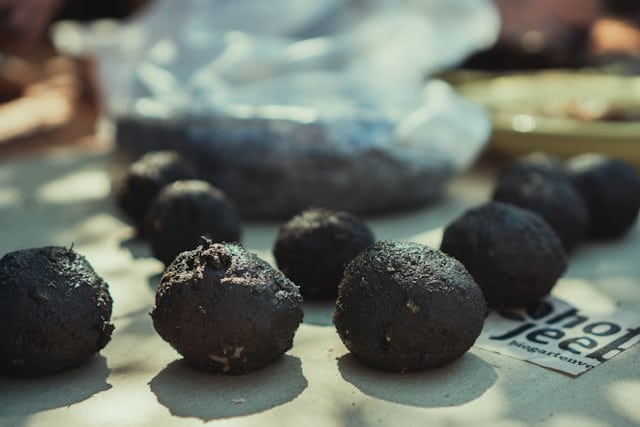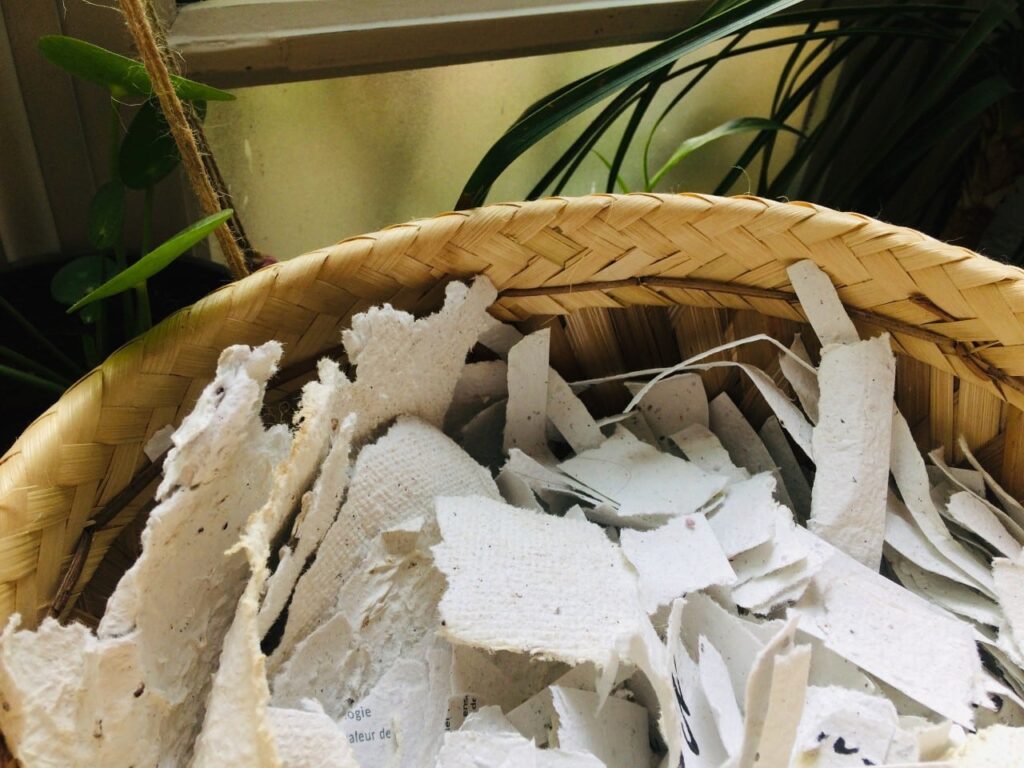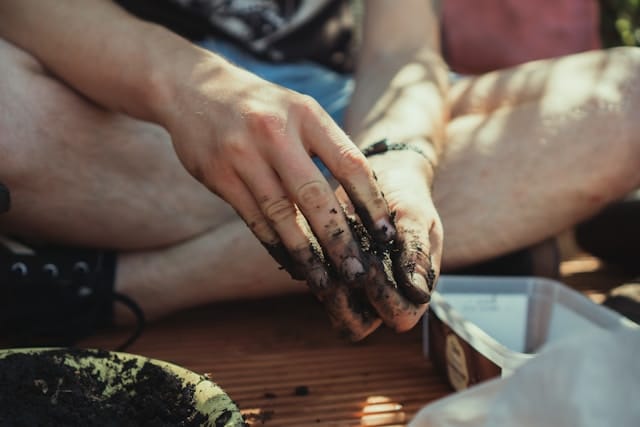In bref:
Introduction
In a world where ecological awareness is becoming increasingly central, the 'zero waste' objective is emerging as a desirable horizon for many environmentally conscious individuals and communities. This movement, which aims to minimise our ecological footprint by reducing waste, invites us to rethink the way we consume and dispose of our resources. Among the many emerging initiatives to promote a more sustainable way of life, seed bombs stand out as a simple, fun and profoundly impactful tool for revegetating our urban and rural spaces.
So what exactly is a seed bomb? Think of it as a small spherical ball, made entirely of biodegradable materials, containing flower or tree seeds ready to germinate. The concept is as simple as it is effective: once dropped on bare soil, the 'bomb' decomposes naturally, allowing the seeds to take root and transform a barren space into a patch of greenery. The other, variable elements in its composition are designed to protect the seeds and encourage them to germinate, even in difficult environments.

In this article, we explore a remarkable innovation in the design of seed bombs: the use of seeded paper scraps. This material choice, which we have made at Parsemains, is in line with the logic of recycling and waste recovery, and brings us even closer to our zero waste objective. By explaining this approach, we invite you to discover how, together, we can always find solutions to transform our waste into resources, through small, simple gestures. Here, we're transforming simple unused scraps of paper into agents for biodiversity.
What is a seed bomb?
The seed bomb, also known simply as a "seed pellet" or "flower bomb", is a little ecological treasure designed to green and revitalise our planet. It's usually a compact sphere made of soil, clay and, of course, seeds. It may sound simple, but it's a powerful "guerrilla gardening" tool, capable of transforming neglected land into flourishing islands that help restore biodiversity.
Origins and history
The history of seed bombs goes back a long way to ancient Egypt, where they were used on the banks of the Nile after floods. Long forgotten, they were rediscovered by the Japanese naturalist and farmer Masanobu Fukuoka, who developed the "Tsuchi Dango" method near the end of the Second World War. This approach, which literally means "pellet of earth", aimed to encourage a more natural and less intrusive form of agriculture. In the 1970s, this concept was popularised and adapted by the guerrilla gardening movement, which sought to green neglected urban spaces, transforming them into centres of biodiversity and beauty.
How it works
A seed bomb works in harmony with natural cycles. When dropped on suitable ground, rain first dissolves the clay and soil, exposing the seeds to the ideal environment for germination. The clay acts as a protector, deterring predators from eating the seeds before they germinate. Over time, these seeds develop into plants, contributing to the beauty, diversity and health of local ecosystems.
Environmental and social benefits
Much more than just a fun gardening tool, seed bombs represent a method of reforestation and ecological revitalisation within everyone's reach. By allowing vegetation to grow in concrete-covered urban areas, they help to reduce the heat island effect, improve air quality and encourage the return of biodiversity. On a social level, they encourage community involvement and raise awareness of the importance of taking care of our environment. Each seed bomb launched is a quick and simple gesture, but one that has a real and direct impact on the environment.
In the current climate of ecological crisis, this simple act of making and throwing seed bombs counts. It reminds us of our ability to have a positive impact on our environment, even through small gestures. By choosing recycled materials, such as seeded paper scraps, for their creation, we are doubling their ecological impact, combining the fight against waste with the fight to preserve and enrich biodiversity.
Why use seeded paper scraps?

In our quest for a greener, zero-waste future, seeded paper scraps represent an invisible but invaluable resource, and we've been thinking for a long time about how they could be reused in a virtuous way. The idea of using it as the base material for our seed bombs, as a way of rethinking and reinventing our relationship with waste, was an obvious one. In fact, some seed bomb recipes already included paper pulp, which serves to strengthen the pellet and helps to nourish the seeds inside. What more could you ask for when you've set your sights on zero waste?
What is seeded paper?
Seeded paper is a type of paper made with embedded seeds. When planted in the ground and properly watered, it germinates and gives rise to plants, herbs or flowers. This process gives paper a second life, transforming a single-use product into a new source of life.
Benefits of recycling seeded paper waste
- Waste reduction : By using seeded paper scraps to make seed bombs, we're reducing our ecological footprint by giving a new purpose to a material that would otherwise be considered waste.
- Promoting biodiversity : The seeds we use in Parsemains seeded paper are organic and chosen to encourage local biodiversity, thereby supporting healthy and resilient ecosystems.
- Environmental education : The process of converting seeded paper into seed bombs offers a unique opportunity to raise community awareness of the importance of sustainable resource management and biodiversity conservation.
Link with the zero waste objective
The use of seeded paper off-cuts is in line with the principles of the zero waste movement: refuse, reduce, reuse, recycle and compost. By choosing to reuse these materials, we are adopting a circular approach that promotes the recycling and reuse of resources. This allows us to minimise our contribution to landfill and incinerators, while creating ecological and aesthetic value.
The choice of materials such as seeded paper to make seed bombs is a perfect example of how zero waste initiatives can be integrated into our daily activities, reinforcing the idea that every action counts. By adopting creative recycling practices, we can all contribute to a more sustainable future, transforming waste into vectors of growth and beauty. So, by turning to seeded paper scraps for our seed bomb projects, we're making a conscious choice for the environment, demonstrating that recycling and preserving nature can go hand in hand in innovative and inspiring ways.
Step-by-step guide to making your own seed bombs
Making seed bombs from seeded paper scraps is a fun and educational activity, perfect if you too are aiming for zero waste. Here's a practical guide to creating your own little biodiversity bombs, turning your rubbish into ecological treasures.
Materials required
- Seeded paper scraps: collect seeded paper scraps, available from eco-friendly printers or creative workshops that use this type of paper.
- Water: to soften the paper and make it easier to convert.
- Additional seeds (optional): depending on the needs of your planting project or the specifics of your region.
- Potting soil, compost or garden soil.
- Clay, preferably white or red.
Preparing the seeded paper
- Shredding : Start by tearing the scraps of seeded paper into small pieces. This will make it easier to obtain a paste. Note: this step is not necessary if you are using Parsemains paper, which is designed to biodegrade as quickly as possible.
- Soaking : Dip the pieces of paper in a bowl with a little water to soften them and obtain a homogeneous paste.
- If necessary, add water a little at a time to adjust the consistency.
Seed bomb manufacturing process
- Add a measure roughly equal to your paper pulp, a measure of potting soil and a measure of clay.
- Take a small amount of the dough and shape into balls the size of a large marble. If you want to add extra seeds, add them at this point. Make sure that each ball contains a balanced mixture of paper and seeds.
- Drying : Place the seed cans on a tray and leave them to dry out completely in a dry, well-ventilated place. This can take between 24 and 48 hours, depending on the ambient humidity. Be sure to turn them over regularly to ensure even drying.
Best practices for optimal seeding and growth
- Timing : Drop your seed bombs at the start of the rainy season or water them regularly to ensure successful germination. The ideal period for germination is from March to October.
- Location: Choose locations that get a little light and where the plants have room to grow.
- Patience: Germination can take time. Keep an eye on your seed bombs and continue to water them if necessary.
By following these steps, you can turn seeded paper scraps into eco-friendly seed bombs, contributing to urban reforestation and the creation of biodiversity hotspots.
It's a great activity to do as a family, or as part of a group workshop. But if you don't necessarily have the time, or if you'd like to introduce your friends and family to this lovely concept, you can also buy our seed bombs made from seeded paper scrapsFor an original and meaningful gift.
To make our own, we mix the dough in our workshop, which we then send to the ESAT des Ateliers de Garlande, less than 2km away, for shaping. Our seed bombs are not only eco-friendlyThey are also ethical and supportive.
Ideas and tips for using your seed bombs
Once your seed bombs are ready, the real journey begins. Using these life capsules to green up neglected areas or enhance local biodiversity can be a rewarding adventure. Here are a few ideas and tips for maximising their potential and getting your community involved in this green initiative.
Suggestions on when and where to use seed bombs
- Urban areas : Waste ground, kerbs and neglected spaces in urban areas are perfect targets for your seed bombs. These small gestures can help transform these spaces into green oases.
- Seasons : The best time to launch your seed bombs is just before the rainy season, allowing nature to do most of the watering work. However, if you live in a drier climate, you may need to water the targeted areas yourself until the plants are well established.
- Communities and schools : Involving local schools and communities in launching seed bombs can not only help green areas but also educate younger generations about the importance of biodiversity and conservation.
Tips for getting the community involved and organising seed bomb launch events
- Educational workshops : Organise workshops where participants can learn how to make their own seed bombs. This increases interest in and commitment to the environmental cause.
- Planting events : Plan community days dedicated to planting seed bombs. This can take the form of green walks, where families and friends get together to sow areas that need green attention.
- Local partnerships : Work with local organisations, businesses and schools to extend the impact of your project. These partnerships can provide additional resources and increased visibility.
Creative ideas for personalising seed bombs and giving them as gifts
- Ecological gifts : Beautifully packaged seed bombs can make meaningful gifts for environmentally conscious friends and family. They're perfect for occasions like birthdays, weddings, or as a gesture of thanks.
- Personalised messages : Add labels or notes with inspirational messages or instructions on how to use seed bombs. This can reinforce the green message and encourage recipients to take action.
- Themed varieties : Create collections of seed bombs based on different themes, such as wildflower mixes to attract pollinators, culinary herbs, or native plants specific to your region. This adds an educational dimension and can target specific ecological needs.
By following these tips and using your seed bombs creatively, you can not only beautify your environment but also inspire others to adopt greener practices. By sharing our passion and commitment to the planet, we can cultivate a more sustainable and resilient future, one step at a time.
Environmental and social impact of seed bombs

The seed bomb initiative, especially when made from seeded paper scraps, embodies a profoundly significant ecological approach. Not only does it help to reduce waste, it also contributes to the regeneration of our ecosystems. Here's a look at the environmental and social impact that these little spheres of life can have.
Contribution to biodiversity
Seed bombs play a crucial role in promoting biodiversity, particularly in urban areas where green space is limited. By transforming wasteland or degraded areas into plant habitats, they provide refuge and food resources for a variety of species, from pollinating insects to birds. This increase in biodiversity is essential to maintaining healthy, resilient ecosystems.
Combating urban depopulation
Urban desertification, characterised by the loss of green spaces to concrete, is a growing problem in many towns and cities. Seed bombs offer a simple and effective solution to reverse this trend, making it easier to create green spaces. These green spaces not only help to improve air quality and reduce urban heat islands, but also create spaces for relaxation and well-being for local communities.
Strengthening community cohesion
As well as their ecological impact, seed bombs have great social potential. They can act as a catalyst to bring people together around a common goal: revitalising and beautifying their environment. Seed bomb planting projects can encourage collaboration between neighbours, schools, associations and local businesses, strengthening community cohesion and identity.
Testimonials and case studies
Successful projects from around the world bear witness to the positive impact of seed bombs. From communities transforming brownfield sites into community gardens to reforestation initiatives in degraded areas, these stories inspire and motivate action. By sharing these experiences, we can encourage others to adopt this simple but powerful practice for the good of our planet.
Towards a broader commitment to the environment
Seed bombs, especially when made from recycled materials such as seeded paper, are an excellent example of how zero waste principles can be integrated into our everyday actions for the environment. They remind us that every gesture counts and that we can all contribute to a more sustainable future.
In conclusion, seed bombs are not just a way of greening our planet; they are a symbol of our ability to positively influence the environment and strengthen our communities. Through these small gestures, we are laying the foundations for a future where harmony with nature is not just an ideal, but a lived reality.
Conclusion
Over the course of this article, we've explored the fascinating world of seed bombs, an ingenious and accessible method of greening and biodiversifying our environments. Using seeded paper scraps, this practice is fully in line with the zero waste objective, transforming what might otherwise have been considered waste into invaluable tools for ecological revitalisation. We have seen how, step by step, everyone can contribute to this initiative, whether by making, using or promoting seed bombs within their community.
These actions, however small, have the potential to have a significant environmental and social impact. They remind us of the importance of every gesture in combating urban desertification, promoting biodiversity and strengthening community links. Commitment through seed bombs echoes a wider call to action for a more sustainable future, where conservation and respect for our environment are not options, but imperatives.
We invite you to embrace this ecological approach, make your own seed bombs from seeded paper scraps and share them with your friends and family. Every seed bomb you make is a seed of hope for our planet, another step towards a future where harmony with nature is restored. Don't hesitate to share your experiences, your successes and even your challenges on social networks or directly on the www.parsemains.com. Together, we can make a difference, one seed bomb at a time.
Let yourself be inspired by this initiative and become, in turn, an agent of change. Because in the great garden of life, every gesture counts, and together we can make a greener, fairer world blossom.

